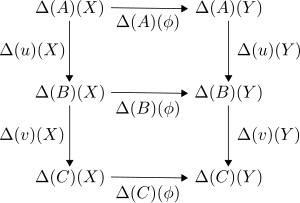Diagonal functor
In the mathematical subfield of category theory , the diagonal functor is a functor that allows a category to be embedded in the category of functors for any non-empty ( small ) category . The name comes from the fact that for a discrete with two elements the diagonal functor is just the mapping .
Definition and functoriality
Be a category and a small category. Then the diagonal functor is defined as a mapping that assigns a natural transformation to each morphism , given that they assign each object and thus each morphism to the morphism . For an object there is obviously a functor. In order to see that is actually a functor, consider the concatenation of natural transformations for morphisms and from the category and , by definition, this results in the following commutative diagram for each :
This is nothing more than:
This corresponds to the natural transformation , which proves that . For non-empty is obviously injective , i.e. embedded in the corresponding functor category . Under a certain condition is also full : be natural transformation, i. i.e. that for each in the diagram
commutes (because and ). Which means nothing else than that whenever a morphism exists between and . If the category as a graph construed weakly connected is, is so constant and thus the image of , which is full. For example, this is true for an arrow category or, more generally, for with a start or end object, but not for a product for discrete with at least two elements.
Connection with limits
A cone with respect to a functor is nothing more than an object in provided with a natural transformation from to . A Limes of is a special cone, namely a - universal solution for . Dual to this is a Kolimes of a special Kokegel, namely a -universal solution for . If has a right adjoint functor , then it is completely up with respect to limits , the converse also applies. This adjoint functor is precisely the Limes functor . Correspondingly, the Kolimes functor (if it exists) is left adjoint to the diagonal functor.
The diagonal functor is continuous , i.e. i.e., it receives all limits that exist in. He also receives all Kolimites.
literature
- Saunders Mac Lane: Categories for the Working Mathematician . 2nd Edition. Springer , New York 1998, ISBN 0-387-98403-8 .
- Dieter Pumplün: Elements of the category theory . 1st edition. Spektrum Akademischer Verlag , Heidelberg 1999, ISBN 3-86025-676-9 .
Web links
- diagonal functor , entry in the nLab . (English)




























